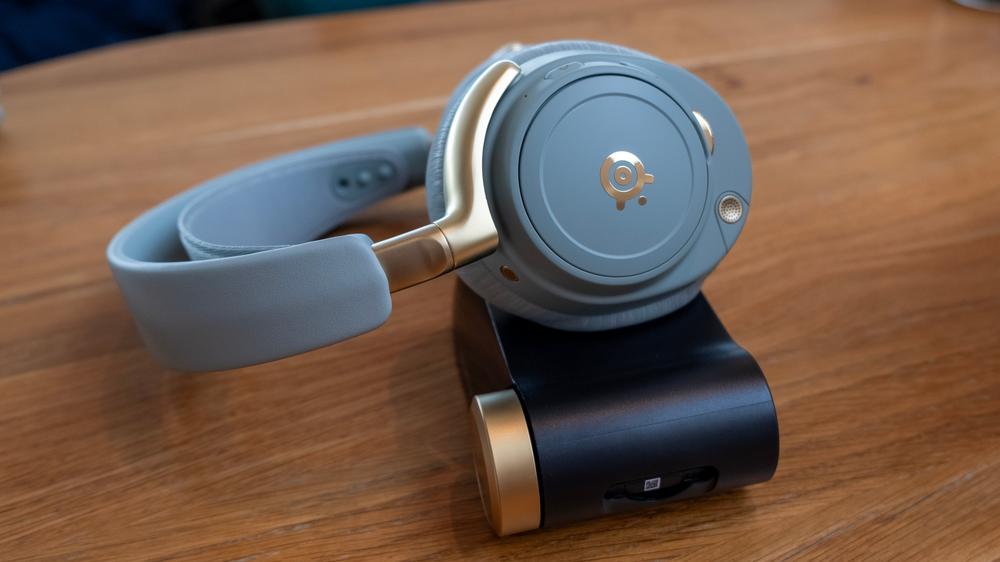By some accounts, SteelSeries invented the concept of a high-end gaming headset with its $329 Arctis Pro Wireless and $349 Arctis Nova Pro Wireless headsets. And indeed, we've seen a long list of other gaming brands follow its lead in offering premium headsets with features like active noise cancellation, multi-device base stations and deep software customization.
Now, SteelSeries is back with an even higher-end model, the $600 Arctis Nova Elite. It comes with redesigned carbon fiber drivers, a more capable four-source base station and hi-res wireless audio certification, but is any gaming headset worth that high a price? After a month of testing, I’m starting to think that the heretofore dormant ultra-premium category might be about to spring into life.
SteelSeries Arctis Nova Elite – Design and Features
At first glance, the Nova Elite looks very similar to the Arctis Nova Pro Wireless released in 2023 – though the classy sage/gold and obsidian colorways at least hint to the upgrades within. The comfortable fabric suspension headband returns intact, with stainless steel and aluminum used throughout the frame to provide a convincingly durable design. The volume wheel has transformed from plastic in the prior models to metal too, with audible steps that provide good feedback to signify the increments in volume change. The memory foam ear cushions complete the headset, providing moderate levels of passive noise cancellation.
Though its gaming origins are unmistakable, this is one of the nicest-looking headsets I've ever tested and it doesn't look garishly out of place next to similarly-priced lifestyle headphones. The black obsidian model is particularly adept at not drawing attention, though its shiny metal accents again attest to a high-end design.
Inside, the 40mm dynamic drivers used in the prior Arctis Nova Pro models have been upgraded to two-piece carbon fiber models, wrapped in a brass surround. SteelSeries says that the new "pistonic" design moves up and down without jitter to avoid distortion, and can reproduce sounds from 10Hz to 40KHz.
The headset makes the most of these internal upgrades too, with 96KHz/24-bit Hi-Res audio over 2.4GHz wireless or the LC3+ Bluetooth codec. The Nova Elite also sports more effective ANC than its predecessor, while the microphone uses a 32KHz/16-bit wide-band connection. If you retract the default microphone, as you might while on-the-go, a new backup beam-forming mic is used instead.
SteelSeries Arctis Nova Elite – Setup and Connectivity
The GameHub base station also sees new ornamentation – with a gold volume wheel on the sage/gold colorway – which is again backed with new functionality. The two USB inputs on the original Arctis Nova Pro Wireless have been upgraded to three, allowing for full-fat digital connections to a PC, PS5, and Xbox for example. And unlike the older Nova Pro model, now two of these connections can be live at once, with the game station automatically selecting the correct inputs based on activity. It’s worth noting that there’s only one version of the Arctis Nova Elite, with the third USB-C input optionally enabling support for Xbox’s proprietary wireless standard, rather than requiring the purchase of an Xbox-specific variant as we’ve seen on past Arctis headsets.
A further fourth 3.5mm input allows for an additional connection, while the headset itself can also maintain a simultaneous Bluetooth connection, with a dedicated on/off button.
Getting set up is extremely straightforward, as it's just a case of running one of the provided USB-C or 3.5mm cables to the source of your choice, or alternatively pairing over Bluetooth.
Once connected, you can long press the back button on the GameHub to change between various display modes, which show the volume level of each source, their equaliser settings, or the current bit-rate and left/right channel levels. Additionally, track data from Tidal is also shown when it is playing, though I wish this extended to all common media players like Spotify or YouTube Music.
Long pressing the volume wheel enters a menu, allowing you to set the third USB input to Xbox or regular mode; change equalizer, gain, noise control, and microphone settings; swap between wireless and Bluetooth; change line out settings; or change system settings like microphone brightness, display brightness, or power-saving modes. It's very much the same system as the Arctis Nova Pro Wireless, with a few extra options that don't feel too overwhelming.
SteelSeries Arctis Nova Elite – Battery Life
The base station also maintains the excellent swappable battery system that's become the trademark of Arctis Pro Wireless headsets, with each battery promising 30 hours of play time. While one battery is being run down inside the headset, the other charges up inside the base station, so you're never left in the lurch.
The switchover is still a little awkward – you need to physically swap in the next battery within five seconds after the first is removed in order for the headset to automatically power itself on again – but it's something that you'll quickly adjust to as an Arctis Nova Elite owner. (The only way to prevent this would be to include a battery or supercapacitor inside the headset itself, which would likely add significant cost and complexity to the design, so it's an understandable restriction.)
In situations where you're without the base station, such as international travel, you can also use a regular USB-C charger to top up the battery. This isn't ideal ergonomically, with the cable coming out of one earcup at a right angle, but I think it's unlikely to be a common occurrence for most users. SteelSeries claims that a 15-minute charging session is sufficient for four hours of usage, so you don't need to top up for long in order to get a decent charge on the headset once again.
In my testing, the Nova Elite managed to keep closely to its 30-hour estimate, and given the ease of swapping to a fresh battery, I never ran into any difficulties. Even on a single battery, I was able to use the headset for a full week of gaming and music listening, averaging four or five hours a day.
SteelSeries Arctis Nova Elite – Software
Aside from its hi-res audio certification, the Arctis Elite offers largely the same PC software experience as its predecessors, complete with a multi-tiered GG app that contains sections for more basic adjustments (Engine), powerful audio programming (Sonar) and additional settings (Moments, 3D Aim Trainer, Giveaways, News). Sonar is incredibly capable, with a parametric EQ and a long list of game-specific equaliser presets, including some created in collaboration with esports teams.
That said, its insistence on creating many additional audio devices can be bothersome if you tend to manually select your desired audio device in Windows, for example. Ideally, you'd want to run everything through the GameHub and SteelSeries' Sonar software, rather than having separate speakers or microphones controlled in different apps, but that may not be practical for some setups.
What's new for the Arctis Elite is the addition of the Arctis mobile app, which was introduced with the Arctis Nova 5 and has been a feature of each additional SteelSeries headset released since. Given the multi-device nature of the Arctis Elite – which ought to see it being used as your everyday Bluetooth headset, your PC gaming headset, and your console headset of choice – having an app to select presets and make other changes quickly is a game-changer. There's still no way to create or modify these presets on the mobile app, but given the huge number of available options, this isn't a terrifically troublesome restriction.
Finally, the full gamut of virtual surround sound modes are supported on each platform – Dolby Atmos and Windows Sonic on PC and Xbox, and Tempest 3D Audio on PS5 – though I preferred to use the headset in stereo mode in faster and more competitive games like Counter-Strike 2, Valorant, and Battlefield 2042.
SteelSeries Arctis Nova Elite – Performance and Gaming
The Arctis Nova Pro Wireless was already an excellent performer when it came to gaming, with its 40mm dynamic drivers providing excellent spatial cues, plenty of detail, and a relatively neutral sound signature out of the box that's easy to listen to for extended periods. The Arctis Nova Elite sounds even better, thanks to its carbon fiber drivers and brass surrounds, making individual sounds a touch easier to distinguish in a crowded soundscape.
Compared to the only other extremely high-end headset I have, the $900 Audeze LCD-GX with its titanic 106mm planar magnetic drivers, the Nova Elite is surprisingly similar while being substantially cheaper, wireless instead of wired, and much more comfortable to wear due to its lighter weight. The inclusion of ANC is also a godsend for louder environments, whether you're trying to clutch in Counter-Strike or just relax with some music on a crowded train.
The Nova Elite's wireless hi-res certification is also intriguing, although as always the issue is that true high-res audio is extremely hard to find outside of a few services like Tidal, and practically unknown in games. I did subscribe to Tidal for the purposes of this review, and found a few small improvements in back-to-back listening sessions with hi-res audio enabled (requiring a settings change in Windows to 24-bit 96KHz) and more standard 16-bit 44.1KHz playback. I wouldn't say that most people ought to care deeply about hi-res audio, especially in the gaming arena, but it is nice to know that the Arctis Nova Elite isn't likely to be the limiting factor here.
The Arctis Nova Elite's microphone also shows a modest improvement, though as usual wired headsets and dedicated USB or XLR microphones will still offer the best quality for more serious use.
Ultimately, there are sure to be audiophile headphones that sound better than the Arctis Nova Elite, but delivering this level of audio quality alongside a full-fat gaming feature list is unheard of – only Audeze's significantly heavier and bulkier planar magnetic headsets come close in my experience.

 Jurassic World Evolution 3: The Final Preview
Jurassic World Evolution 3: The Final Preview